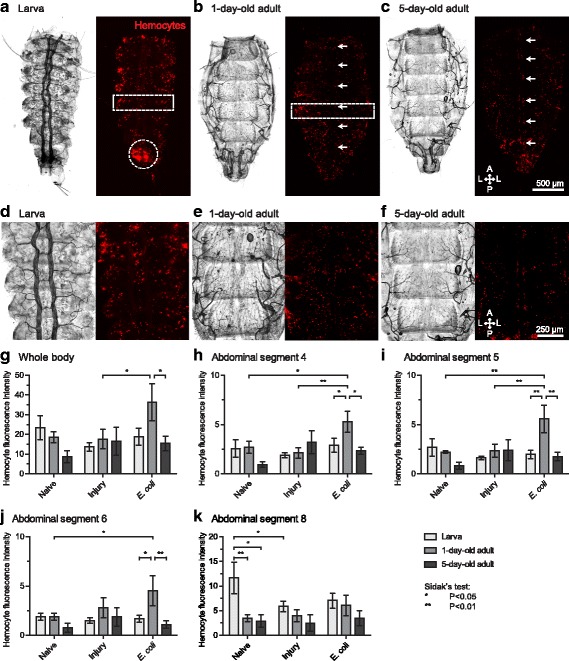Fig. 3.

Sessile hemocyte arrangement and aggregation across life stages and in response to infection. a-f Dissected larva (a, d), 1-day-old adult (b, e) and 5-day-old adult (c, f) dorsal and lateral abdomens viewed under bright-field and fluorescence illumination at 24 h post-infection with E. coli. d-f show higher magnification images of segments 4, 5 and 6. Hemocytes were stained with CM-DiI (red). Larvae showed segmentally arranged hemocytes (box in a) as well as a high concentration of hemocytes in the 8th abdominal segment (circle in a). One-day-old adults showed an abundance of segmental hemocytes (box in b), including periostial hemocytes (arrows in b). Five-day-old adults displayed a similar arrangement except that segmental hemocytes were more dispersed, and periostial hemocytes were more distinct (arrows in c). Directional arrows: A, anterior; P, posterior; L, lateral. g-k Total fluorescence intensity of CM-DiI-stained hemocytes from the dorsal and lateral abdomen for abdominal segments 2–8 combined (g) or from abdominal segments 4 (h), 5 (i), 6 (j) and 8 (k) alone in naïve, injured, and infected larvae, 1-day-old adults and 5-day-old adults at 24 h post-treatment. Quantitative data were analyzed by two-way ANOVA, followed by Šidák’s post-hoc test. In g-k, whiskers denote the SEM. Data for abdominal segments 2, 3 and 7 are presented in Additional file 3: Fig. S2 and data for hemocyte counts in abdominal segments 4, 5 and 6 (d-f) are presented in Additional file 4: Fig. S3
